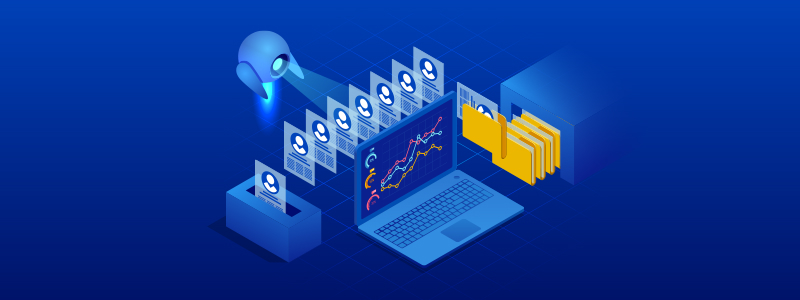
EDI VAN: Everything You Need to Know about Value-Added Networks (VAN) in EDI
The global EDI market, valued at USD 36.52 billion in 2023, has a projected compound annual growth rate (CAGR) of 12% from 2024 to 2032. As organizations worldwide increasingly turn to EDI to enhance their business processes, the role of VANs in facilitating seamless data interchange has garnered significant attention.
This blog provides a comprehensive overview of EDI VANs, detailing their functionalities, benefits, and important aspects to consider when selecting the right EDI communication method.
What Is an EDI VAN?
EDI VANs are third-party service providers that manage electronic document exchanges between trading partners. VANs act as intermediaries that receive, store, and transmit EDI messages securely and efficiently.
VANs add value by offering various services beyond basic data transmission, such as message tracking, error detection, and data translation. They help businesses manage their EDI communications and handle the technical challenges associated with direct EDI connections.

What are the Benefits of Using an EDI VAN?
- Security and Compliance:
- VANs provide secure data transmission, protecting sensitive information during transit. They also comply with industry standards and regulations, such as the HIPAA for healthcare and the GDPR for data protection, which helps businesses meet compliance requirements.
- Data Translation and Integration: VANs offer data translation services, converting documents from one format to another to ensure compatibility between different EDI systems. This enables seamless integration with various trading partners, regardless of their EDI standards or software.
- Simplified Partner Onboarding: VANs streamline onboarding new trading partners by handling the technical aspects of EDI integration. This reduces the time and effort required to establish EDI connections, allowing businesses to expand their partner networks more quickly.
- Error Detection and Resolution: VANs provide detection and resolution services, identifying issues in EDI messages and alerting businesses to take corrective action. This reduces the risk of failed transactions and ensures that documents are processed accurately.
- Tracking and Reporting: VANs offer comprehensive tracking and reporting tools, allowing businesses to monitor the status of their EDI messages in real-time. This visibility helps companies manage their EDI operations more effectively and make informed decisions.
Types of VANs in EDI
VANs come in various forms, each offering different services and capabilities. The four most common types of EDI VANs are:
-
Public VANs
Public VANs are shared networks used by multiple businesses. Due to their shared infrastructure, they offer standard EDI services, such as data transmission, translation, and tracking, at a lower cost. Public VANs are suitable for small—to medium-sized businesses with moderate EDI needs.
-
Private VANs
Private VANs are dedicated networks used by a single organization or a group of related companies. They provide customized EDI services tailored to the organization’s specific needs and offer higher levels of security, reliability, and control. Private VANs are ideal for large enterprises with complex EDI requirements.
-
Industry-Specific VANs
Industry-specific VANs cater to the healthcare, retail, and automotive industries’ unique needs. They offer specialized EDI services and compliance features relevant to the industry, ensuring that businesses can meet regulatory requirements and industry standards.
-
Cloud-Based VANs
Cloud-based VANs use cloud computing technology to provide scalable and flexible EDI services. They offer on-demand access to EDI capabilities, allowing businesses to adjust usage based on their needs. Cloud-based VANs are easy to implement, making them suitable for businesses of all sizes.
How Do VANs Work? A Step-by-Step Guide

-
Document Preparation
The sender prepares an EDI document, such as a purchase order or invoice, using their EDI software. For example, a company might create a purchase order for 100 units of a specific product formatted according to the 850 Transaction set of the X12 Standard, making it ready for transmission.
-
Transmission to VAN
The sender’s EDI system transmits the purchase order to the VAN. This transmission can be done via various communication protocols, such as FTP, AS2, or a dedicated EDI connection. The VAN receives the document and validates its format and content to ensure it meets the EDI 850 Transaction set of the X12 Standard.
-
Data Translation
If necessary, the VAN translates the purchase order from the sender’s EDI 850 format to the recipient’s format. This ensures that the purchase order is compatible with the recipient’s EDI system and can be processed correctly.
-
Message Routing
The VAN determines the appropriate routing for the purchase order based on the recipient’s information. Then it forwards the document to the recipient’s EDI system via the specified communication protocol.
-
Acknowledgment and Tracking
Upon successful delivery, the VAN generates an acknowledgment message (999 transaction set) confirming receipt of the purchase order by the recipient. The message also includes information about whether the file has any errors. The sender can track their purchase order status through the VAN’s reporting tools, ensuring transparency and accountability.
-
Error Handling
If any issues are detected during transmission or processing, the VAN notifies the sender and provides details about the error.
Limitations of VANs
While EDI VANs offer numerous benefits, they also have certain limitations that businesses should consider:
- Cost: VANs can be expensive, especially for small businesses with limited EDI requirements. The costs associated with using a VAN include setup, subscription, and transaction fees, which can add up over time.
- Dependency on Third Parties: Relying on a third-party VAN means businesses have less control over their EDI operations. Any issues or downtime experienced by the VAN can impact the business’s ability to send and receive EDI messages.
- Complexity: Using a VAN adds a layer of complexity to EDI communications. Businesses must manage their interactions with the VAN and ensure that their EDI documents are properly formatted and transmitted.
- Limited Flexibility: VANs may offer a different flexibility and customization than EDI integration solutions. Businesses with unique or highly specific EDI requirements may need help configuring the VAN to meet their needs.
- Limited Strategic Visibility: EDI VANs often need more transparency than other systems provide. Tracking audit trails or investigating data issues can be difficult, especially with interconnected VAN networks. This lack of visibility creates a “black box” effect, leaving customers uncertain about their EDI transactions. They must rely on the provider to handle connections, updates, and communications, particularly during maintenance or service disruptions.

Alternatives to a VAN for EDI
While VANs have been a popular choice for EDI communication for many years, they may not be the optimal solution for every organization. Factors such as budget, scalability, and control over infrastructure need careful consideration. Businesses seeking alternatives to VANs for their EDI communications have several options to consider, such as:
EDI via AS2
AS2 (Applicability Statement 2) is an Internet communications protocol that enables data to be transmitted securely over the Internet. By using AS2, businesses can establish direct connections with their trading partners, reducing the dependency on third-party providers. AS2 offers strong security features, such as encryption and digital signatures, making it a suitable option for businesses with stringent security +requirements, such as businesses operating in the retail and manufacturing industries. However, AS2 requires technical expertise and resources to implement and manage.

EDI via FTP/VPN, SFTP, FTPS
FTP, SFTP, and FTPS are commonly used communication protocols for the exchange of EDI documents via the Internet. These protocols can be used to connect to business partners directly (Direct EDI) or via an EDI Network Services Provider. Each protocol offers secure data transmission, catering to different security and infrastructure needs.

Web EDI
Web EDI is an approach to EDI that leverages Internet technologies to facilitate the electronic exchange of business documents. This methodology eliminates the need for costly VAN services by using the web for communication. It is more suited for companies that only need to use EDI occasionally.
EDI Integration Platforms
EDI integration platforms offer cloud-based EDI services with advanced features such as data translation, automation, and integration with ERP systems. These platforms provide a modern and flexible alternative to traditional VANs, supporting various EDI standards and protocols. They often include built-in compliance tools to ensure industry-specific regulations and standards adherence. These platforms offer scalability, allowing businesses to expand their EDI capabilities as they grow without significant upfront investment.
EDI VAN vs. Modern EDI Tools
Modern EDI integration tools offer several advantages over traditional VANs, making them a compelling choice for businesses seeking to enhance their EDI capabilities. The following chart compares EDI VANs and modern EDI tools:
| Feature/Aspect | EDI VAN | Modern EDI Tools |
| Cost | Typically higher due to subscription fees and per-transaction charges. | Generally lower; pay-as-you-go or subscription-based. |
| Setup and Maintenance | Complex setup, often requiring specialized IT knowledge. | Easier setup with user-friendly interfaces and automated updates. |
| Scalability | Limited; scaling can be expensive and time-consuming. | Highly scalable, especially with cloud-based solutions. |
| Flexibility | Less flexible, often rigid in terms of integration and customization. | Highly flexible with API integrations and customization options. |
| Speed of Implementation | Slower, due to complex setup and configuration. | Faster, with quick deployment and easy integration. |
| Reliability | High reliability with guaranteed delivery and tracking. | High reliability, but depends on the provider and internet connectivity. |
| Compliance | Generally compliant with industry standards (e.g., HIPAA, EDIFACT). | Also compliant, with frequent updates to meet new standards. |
| Data Management | Basic data management capabilities. | Advanced data analytics and reporting features. |
| Partner Connectivity | Often requires separate connections for each partner. | Simplified partner management with unified connections. |
| Innovation and Updates | Slower to adopt new technologies. | Rapid adoption of new technologies and frequent updates. |
| Support | Traditional support with potential delays. | Real-time support and extensive online resources. |
Why Choose Modern EDI Tools Over VANs?
- Cost Efficiency: Modern EDI tools can be more cost-effective, especially for small to medium-sized businesses, as they often have lower upfront costs and flexible pricing models.
- Ease of Use: Modern tools offer user-friendly interfaces, making it easier for non-technical users to manage EDI processes without extensive IT support.
- Integration: Modern EDI solutions seamlessly integrate with other business applications (e.g., ERP, CRM) through APIs, enhancing overall business process efficiency.
- Scalability: Cloud-based EDI solutions can easily scale to accommodate growing business needs, whereas traditional EDI VANs may require significant investment to scale.
- Security and Compliance: EDI VAN and modern EDI tools offer robust security features but ensuring that the chosen solution meets specific industry compliance requirements is essential.
- Futureproofing: Modern EDI tools are better equipped to adopt new technologies and standards, ensuring long-term viability and competitiveness
How Astera Improves EDI Management
Astera, a leading provider of no-code data integration solutions, offers an end-to-end automation solution for transferring and translating EDI messages. It enables seamless connectivity with all EDI partners via the cloud or internal systems and supports various industry standards like X12, EDIFACT, and HL7.
Key highlights of the solution include:
- Seamless Connectivity: Connects with all EDI partners across various industry groups, ensuring secure data exchange and integration.
- Quick Onboarding: Simplifies the onboarding of trading partners, internal systems, and cloud applications, ensuring reliable connectivity and integration.
- Cost Reduction: Reduces ownership costs by eliminating the need for dedicated EDI experts and Value-Added Networks (VANs).
- Versatile Communication Protocols: Supports multiple protocols like AS2, FTP, SFTP, and APIs, enabling real-time file ingestion from trading partners.
- Scalability and Flexibility: Offers scalable and flexible deployment options, supporting both on-premises and cloud environments.
- Automated Workflows: Provides automated processes for loading, validating, and transforming EDI transactions, keeping organizations aligned with partner requirements.
Final Words
VANs have historically been essential for secure and efficient EDI communications. While traditional VANs offer numerous benefits, modern EDI tools provide greater flexibility, cost-efficiency, and advanced features. Astera’s EDIConnect provides a comprehensive, no-code platform that simplifies EDI management, automates workflows, and ensures seamless integration with trading partners.
Ready to optimize EDI operations? Request a personalized demo of Astera EDIConnect today and discover how it can revolutionize and streamline your EDI management.
 Astera AI Agent Builder - First Look Coming Soon!
Astera AI Agent Builder - First Look Coming Soon!

